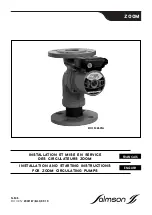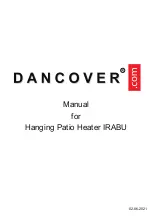
For this type of installation, it is best to use a
draft control for each water heater located
on the riser between the vent outlet and the
breeching - Location “A”. When this riser is
too short to permit the installation of a draft
control, locate a separate control for each
water heater on the main breeching as
illustrated in Location “B”. If, because of
general crowding or other reasons, neither
of these locations are possible, use a single
large control in the breeching between the
water heater nearest the chimney and the
chimney, as shown in Location “C”.
All draft readings are made while unit is in
stable operation (approximately 5 minutes
running time).
Masonry Chimney
A masonry chimney
must
be properly sized
for the installation of a high efficiency gas
fired appliance. Exterior masonry chimneys,
with one or more sides exposed to cold
outdoor temperatures, are more likely to
have venting problems. The temperature of
the flue products from a high efficiency
appliance may not be able to sufficiently
heat the masonry structure of the chimney to
generate proper draft. This will result in
condensing of flue products, damage of the
masonry flue/tile, insufficient draft and
possible spillage of flue products into an
occupied living space.
Carefully inspect all chimney systems during
the project design phase. If there is any doubt
about the sizing or condition of a masonry
chimney, it is prudent to reline the chimney
with a properly sized and approved chimney
liner system. Metallic liner systems (Type “B”
doublewall or flexible or rigid metallic liners)
are recommended. Consult with local code
officials to determine code requirements or the
advisability of using or relining a masonry
chimney.
OUTDOOR INSTALLATION
Units are self venting and can be used
outdoors when installed with the optional
Outdoor Cap. This cap mounts directly to
the top of the water heater and covers the
flue outlet and combustion air inlet openings
on the jacket. No additional vent piping is
required. Maintain a minimum clearance of
3
”
(76 mm) to combustible surfaces and a
minimum of 3
”
(76 mm) clearance to the air
inlet.
L o c h i n v a r
D E S I G N E R
’
S
G U I D E
C O P P E R
-
F I N
W A T E R
H E A T E R
6 1 5 - 8 8 9 - 8 9 0 0
9
NOTE:
Common venting
systems may be too
large when an existing
unit is removed. Be
careful to resize any
common venting system
when new appliances
are installed or existing
appliances are replaced.
NOTE:
Flue gases will form a
white plume in winter.
Plume could obstruct
window view. Flue gas
condensate can freeze
on exterior surfaces or
on the vent cap. Flue
gas condensate can
cause discoloration of
exterior building
surfaces. Adjacent brick
or masonry surfaces
should be protected with
a rust resistant sheet
metal plate.
(FIG. 8) MULTIPLE UNIT BAROMETRIC
DAMPER INSTALLATION
(FIG. 9) OUTDOOR VENTING
NOTE:
Venting of a high
efficiency appliance into
a cold or oversized
masonry chimney can
result in operational and
safety problems.
Содержание Copper-Fin CW 495
Страница 1: ...DESIGNER S GUIDE COPPER FIN WATER HEATER 4 9 5 0 0 0 2 0 6 5 0 0 0 B t u h r...
Страница 23: ......










































